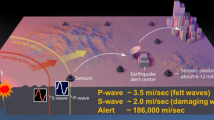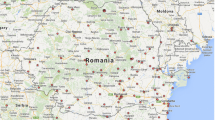Abstract
The earthquake early warning (EEW) system in Taiwan is the outcome of rigorous research work carried out at various levels after the occurrence of the 1986 Hualien earthquake that caused destruction. After more than 25 years of development, three different EEW systems exist in Taiwan. Currently, the nation wide regional EEW system is operated by the Central Weather Bureau (CWB), whereas, a hybrid (regional & onsite) system based on Micro-Electro-Mechanical System sensors is run by National Taiwan University (NTU). The third EEW (onsite system) is run by the National Center for Research on Earthquake Engineering (NCREE). Both CWB and NTU systems are capable of reporting the EEW warnings within 20 seconds of earthquake occurrence. The CWB system is incharge of providing earthquake alerts in Taiwan via text message through mobile phone, TV, and directly broadcasting system to schools and is providing earthquake alarms to the general public since 2016. During recently damaging earthquakes in Taiwan, the NTU system provided 2–8 seconds onsite warning (lead time) in the blind zone around the epicenter. The NTU system also can generate near real-time shake maps for rapid response purposes. The NCREE system consists of about 98 stations and can provide several seconds lead time in the area near the epicenter. The NCREE system also can receive CWB regional EEW messages for warning the regions away from the epicenter. Individually every system has its advantage, however, the hybrid approach will be one of the future systems for real operation.
Similar content being viewed by others
References
Chen, D.Y., Lin, T.L., Wu, Y.M., Hsiao, N.C. (2012) Testing a P-wave earthquake early warning system by simulating the 1999 Chi-Chi, Taiwan, Mw 7.6 Earthquake. Seismol. Res. Let., v.83, pp.103–108. doi: https://doi.org/10.1785/gssrl.83.1.103
Chen, D.Y., Hsiao, N.C., Wu, Y.M. (2015) The Earthworm based earthquake alarm reporting system in Taiwan. Bull. Seismol. Soc. Amer., v.105, pp.568–579. doi: https://doi.org/10.1785/0120140147
Chen, D.Y., Lin, T.L., Hsu, H.C., Hsu, Y.C., Hsiao, N.C. (2019) An approach to improve the performance of the earthquake early warning system for the 2018 Hualien earthquake in Taiwan. Terr. Atmos. Ocean. Sci., v.30, pp.423–433. doi: https://doi.org/10.3319/TAO.2018.12.23.02
Espinosa-Aranda, J., Jime’nez, A., Ibarrola, G., Alcantar, F., Aguilar, A., Inostroza, M., Maldonado, S. (1995) Mexico City seismic alert system. Seismol. Res. Lett., v.66, pp.42–53.
Hsiao, N.C., Wu, Y.M., Shin, T.C., Zhao, L., Teng, T.L. (2009) Development of earthquake early warning system in Taiwan. Geophys. Res. Lett., v.36(L00B02). doi: https://doi.org/10.1029/2008GL036596
Hsiao, N.C., Wu, Y.M., Zhao, L., Chen, D.Y., Huang, W.T., Kuo, K.H., Shin, T.C., Leu, P.L. (2011) A new prototype system for earthquake early warning in Taiwan. Soil Dyn. Earthquake Eng., v.31, pp.201–208. doi: https://doi.org/10.1016/j.soildyn.2010.01.008
Hsieh, C.Y., Wu, Y.M., Chin, T.L., Kuo, K.H., Chen, D.Y., Wang, K.S., Chan, Y.T., Chang, W.Y., Li, W.S., Ker, S.H. (2014) Low cost seismic network practical applications for producing quick shaking maps in Taiwan. Terr. Atmos. Ocean. Sci., v.25, pp.617–624. doi: https://doi.org/10.3319/TAO.2014.03.27.01(T)
Hsieh, C.Y., Chao, W.A., Wu, Y.M. (2015) An examination of the threshold-based earthquake early warning approach using a low cost seismic network. Seismol. Res. Let., v.86, pp.1664–1667. doi: https://doi.org/10.1785/0220150073
Hsu, T. Y., Huang, S. K., Chang, Y. W., Kuo, C. H., Lin, C. M., Chang, T. M., Wen, K. L., Loh, C. H. (2013) Rapid on-site peak ground acceleration estimation based on support vector regression and P-wave features in Taiwan, Soil Dynamics and Earthquake Engineering, v.49, pp.210–217. doi: https://doi.org/10.1016/j.soildyn.2013.03.001
Hsu, T.Y., Wang, H.H., Lin, P.Y., Lin, C.M., Kuo, C.H., Wen, K.L. (2016) Performance of the NCREE’s on-site warning system during the 5 February 2016 Mw 6.53 Meinong earthquake. Geophysical Research Letters, v.43, pp.8954–8959. doi:https://doi.org/10.1002/2016GL069372
Hsu T.Y., Lin, P.Y., Wang, H.H., Chiang, H.W., Chang, Y.W., Kuo, C.H., Lin, C.M., Wen, K.L. (2018a) Comparing the performance of the NEEWS earthquake early warning system against the CWB system during the February 6 2018 Mw 6.4 Hualien earthquake. Geophys. Res. Lett., v.45, pp.6001–6007. doi: https://doi.org/10.1029/2018GL078079
Hsu, T.Y., Yin, R.C., Wu, Y.M. (2018b) Evaluating post-earthquake building safety using economical MEMS seismometers. Sensors, v.18(1437). doi: https://doi.org/10.3390/s18051437
Hsu, T.Y., Kuo, C.H., Wang, H.H., Chang, Y.W., Lin, P.Y., Wen, K.L. (2021) The realization of an earthquake early warning system for schools and its performance during the 2019 ML 6.3 Hualien (Taiwan) earthquake. Seismol. Res. Lett., v.92(1), pp.342–351. doi: https://doi.org/10.1785/0220190329.
Jan, J.C., Chao, W.A., Wu, Y.M., Chen, C.C., Lin, C.H. (2017) How Well Can We Extract the Permanent Displacement from Low-Cost MEMS Accelerometers?. Sensors, v.17(2643). doi: https://doi.org/10.3390/s17112643
Jan, J.C., Huang, H.H., Wu, Y.M., Chen, C.C., Lin, C.H. (2018) Near realtime estimates on earthquake rupture directivity using near-field ground motion data from a dense low-cost seismic network. Geophys. Res. Lett., v.45, pp.7496–7503. doi: https://doi.org/10.1029/2018GL078262
JMA operational evaluation report, Japan Meteorological Agency, 2016. (In Japanese).
Mittal, H., Yang, B.M., Tseng, T.L., Wu, Y.M. (2021) Importance of real-time PGV in terms of lead-time and shakemaps: Results using 2018 ML 6.2 & 2019 ML 6.3 Hualien, Taiwan earthquakes. Jour. Asian Earth Sci., v.220, 104936. doi: https://doi.org/10.1016/j.jseaes.2021.104936
Nakamura, Y. (1988) On the urgent earthquake detection and alarm system (UrEDAS). Proc. of the 9th World Conference on Earthquake Engineering, v.7(13-2-12), August 2–9, Tokyo-Kyoto, Japan.
Satriano, C., Wu, Y.M., Zollo, A., Kanamori, H. (2011) Earthquake early warning: concepts, methods and physical grounds. Soil Dyn. Earthquake Eng., v.31, pp.106–118. doi: https://doi.org/10.1016/j.soildyn.2010.07.007
Wang, K.S., Chao, W.A., Mittal, H., Wu, Y.M (2018) Building Effects on the P Alert Based Real Time Shaking Map Determination. Seismol. Res. Lett., v89, pp. 2314–2321. doi: https://doi.org/10.1785/0220170252
Wessel, P. and Smith, W.H.F., 1998. New, improved version of generic mapping tools released. Eos, Trans. Amer. Geophys. Union. doi: https://doi.org/10.1029/98EO00426
Wu, Y.M. (2015) Progress on development of an earthquake early warning system using low cost sensors. Pure Appl. Geophys., v.172, pp.2343–2351. doi: https://doi.org/10.1007/s00024-014-0933-5
Wu, Y.M. and Lin, T.L. (2014) A test of earthquake early warning system using low cost accelerometer in Hualien, Taiwan. In: F. Wenzel and J. Zschau (Eds.), Early Warning for Geological Disasters — Scientific Methods and Current Practice, published by Springer. Springer Berlin Heidelberg New York, pp.253–261. doi: https://doi.org/10.1007/978-3-642-12233-013.
Wu, Y. M. and Teng, T.L. (2002) A virtual sub-network approach to earthquake early warning. Bull. Seismol. Soc. Amer., v.92, pp.2008–2018.
Wu, Y.M. and Zhao, L. (2006) Magnitude estimation using the first three seconds P-wave amplitude in earthquake early warning. Geophys. Res. Lett., v.33(L16312).
Wu, Y.M., Shin, T.C., Tsai, Y.B. (1998) Quick and reliable determination of magnitude for seismic early warning. Bull. Seismol. Soc. Amer., v.88, pp.1254–1259.
Wu, Y.M., Chung, J.K., Shin, T.C., Hsiao, N.C., Tsai, Y.B., Lee, W.H.K., Teng, T.L. (1999) Development of an integrated seismic early warning system in Taiwan—case for the Hualien area earthquakes. Terr. Atmos. Ocean. Sci., v.10, pp.719–736.
Wu, Y.M., Teng, T.L., Shin, T.C., Hsiao, N.C. (2003) Relationship between peak ground acceleration, peak ground velocity, and intensity in Taiwan. Bull. Seismol. Soc. Amer., v.93, pp.386–396.
Wu, Y.M., Lin, T.L., Chao, W.A., Huang, H.H., Hsiao, N.C., Chang, C.H. (2011) Faster short-distance earthquake early warning using continued monitoring of filtered vertical displacement a case study for the 2010 Jiasian earthquake, Taiwan. Bull. Seismol. Soc. Amer., v.101, pp.701–709. doi: https://doi.org/10.1785/0120100153
Wu, Y.M., Chen, D.Y., Lin, T.L., Hsieh, C.Y., Chin, T.L., Chang, W.Y., Li, W.S., Ker, S.H. (2013) A high density seismic network for earthquake early warning in Taiwan based on low cost sensors. Seismol. Res. Let., v.84, pp.1048–1054. doi: https://doi.org/10.1785/0220130085
Wu, Y.M., Hsiao, N.C., Chin, T.L., Chen, D.Y., Chan, Y.T., Wang, K.S. (2015) Earthquake early warning systems in Taiwan. In: M. Beer, E. Patelli, I. Kougioumtzoglou, and S.K. Au (Eds.), Encyclopedia of Earthquake Engineering. Springer. doi: https://doi.org/10.1007/978-3-642-36197-5_99-1
Wu, Y.M., Liang, W.T., Mittal, H., Chao, W.A., Lin, C.H., Huang, B.S., Lin, C.M. (2016) Performance of a low-cost earthquake early warning system (P-alert) during the 2016 ML 6.4 Meinong (Taiwan) earthquake. Seismol. Res. Let., v.87, pp.1050–1059. doi: https://doi.org/10.1785/0220160058
Wu, Y.M., Mittal, H., Huang, T.C., Yang, B.M., Jan, J.C., Chen, S.K. (2019) Performance of a low-cost earthquake early warning system (P-Alert) and shake map production during the 2018 Mw 6.4 Hualien (Taiwan) earthquake. Seismol. Res. Lett., v.90, pp.19–29. doi: https://doi.org/10.1785/0220180170
Yang, B.M., Mittal, H., Wu, Y.M. (2021) Real-time production of PGA, PGV, Intensity, and Sa shakemaps using dense MEMS-based sensors in Taiwan. Sensors, v.21(943). doi: https://doi.org/10.3390/s21030943.
Acknowledgments
We would like to thank Prof. Harsh Gupta for providing the opportunity to present the development of Taiwan earthquake early warning systems. The authors gratefully acknowledge the Ministry of Science and Technology (MOST), Taiwan for sponsoring the project, under which this study was carried out. Our work was also supported by the Research Center of Future Earth of the National Taiwan University (NTU) and the National Center for Research on Earthquake Engineering, Taiwan (NCREE). This work was also financially supported by the NTU Research Center for Future Earth from the Featured Areas Research Center Program within the framework of the Higher Education Sprout Project by the Ministry of Education (MOE) in Taiwan. The author (HM) is thankful to Dr. O.P. Mishra, Director, National Centre for Seismology, Ministry of Earth Sciences, India for providing necessary support to participate in present work.The GMT software from Wessel and Smith (1998) was used in plotting most of the figures and is gratefully acknowledged.
Author information
Authors and Affiliations
Corresponding author
Rights and permissions
About this article
Cite this article
Wu, YM., Mittal, H., Chen, DY. et al. Earthquake Early Warning Systems in Taiwan: Current Status. J Geol Soc India 97, 1525–1532 (2021). https://doi.org/10.1007/s12594-021-1909-6
Received:
Accepted:
Published:
Issue Date:
DOI: https://doi.org/10.1007/s12594-021-1909-6




